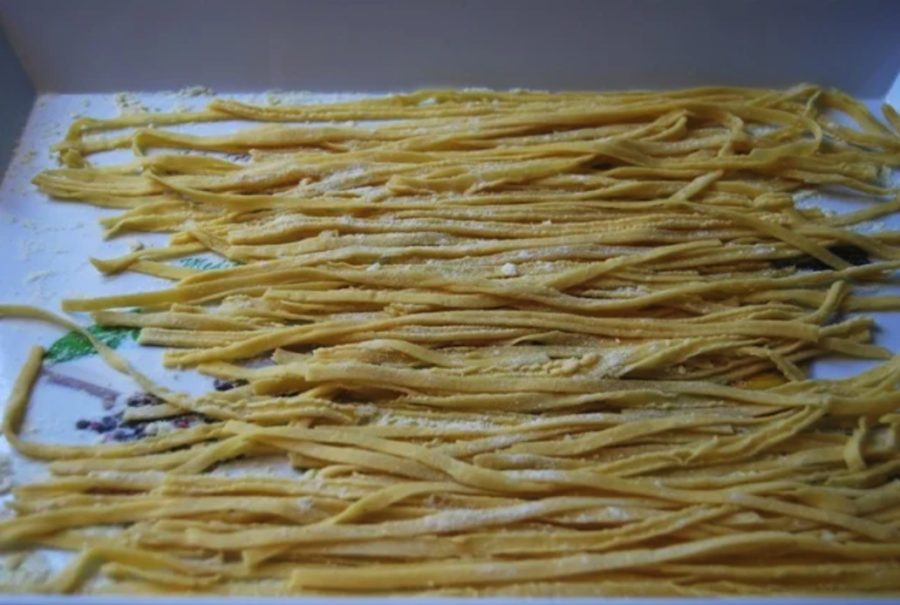Two-Ingredient Pasta!
Homemade Pasta
Difficulty: 3/5
Ingredients:
Flour
Eggs
Store-bought pasta can be found on dinner tables across the country nowadays, but 200 years ago, the dish wasn’t nearly as popular in America. As Italian immigrants introduced pasta to Americans in the late 19th century and the country continued to industrialize, the prevalence of factory-made, boxed pasta surged through the U.S. However, as pasta became increasingly altered in quality to maximize profit for corporations, the integrity of the millennium-old dish was lost. Fortunately for home cooks, pasta only requires two ingredients, which means we modern Romans can still taste the same authentic pasta the ancient Romans ate in any kitchen, at any time.
My sister Julia, a sixth grader at Latin, said “the homemade pasta [Luca] made was the best pasta I’ve ever had. I couldn’t believe there were only two ingredients.” The rest of my family had a similar reaction the first time they tried it.
Sophomore Juliette Katz has also made her own homemade pasta before. “It tasted just like the pasta that I ate in Italy, if not better,” she said. “I encourage everyone to try making it, even if it’s not good the first time. It’s one of those things you have to master over time.”
Pasta dough requires only flour and water, but replacing water with eggs, as they do in Northern Italy, is optimal, although it is more expensive. Eggs add a richness and silkiness to the dough, and they also add a more delectable yellow tint to the pasta.
While typical hen-eggs don’t exist in many variations, flour does. All flour options will suffice, but a special Italian flour—00 flour, also known as doppio zero, works the best, as it is more powdery and smooth than all-purpose, the second-best option. However, the key to delicious pasta lies in the technique, not the ingredients.
Exact measurements are neither necessary nor effective, as eggs come in all sizes, and they combine with the flour differently each time, depending on the maker’s technique. Still, a 1:1 ratio of eggs to cups of flour is a good baseline.
Step 1: Dump flour onto a sturdy cutting board or any flat surface.
Step 2: Mold a well-shape into the flour by pressing a medium size bowl into the center of the flour. This crater of flour will hold the eggs better so the liquid doesn’t spill all over.
Step 3: Add the eggs to the flour-well and gently break them with a fork. Once the yolks are slightly broken, slowly whisk the eggs, scraping in some of the flour from the bottom or knocking some in from the sides.
Step 4: Keep combining the eggs and flour until the mass becomes too hard to mix with a fork, then use your hands to mix until the mass becomes dough-like. Start to knead for at least five minutes until the dough becomes smooth and more elastic. Kneading is simply folding air into the dough to activate gluten.
Step 5: Once you have worked the dough enough to where it slightly bounces back when it is pressed, tightly wrap the ball of dough in plastic wrap and store in a cool, dark cupboard for 30 minutes. This allows further gluten activation, and the dough will become much softer and silkier.
Step 6: Bring the dough back to the working space and knead it again for at least five minutes. This will feel much easier and cleaner than before.
Step 7: Roll the dough out with a rolling pin as thin as possible, or feed it through a pasta roller machine, if you have one at home. Then, slice the sheet of pasta with a knife into any shape you want, or feed the sheets through the shape cutters on the machine.
Now you can cook the pasta and serve it with your favorite sauce, or you can save it for weeks by letting it dry on the counter for 24 hours. Make sure you dust some flour over the pasta before it dries to ensure that it does not stick. Also, don’t forget to save your pasta water if you plan to make a sauce after, as the starchy water will give the sauce a creamy consistency. Enjoy!
One of my favorite sauces to pair with pasta is a vodka sauce. Here is a simple version that I make when I don’t feel like prepping many ingredients or don’t have much time:
Ingredients:
Garlic cloves
Red pepper flakes
Tomato paste
Vodka
Step 1: Sauté garlic and red pepper flakes in olive oil on medium heat.
Step 2: Add about 3-4 tbsp of tomato paste to the pan and season with salt and pepper.
Step 3: After one to two minutes, some of the paste may start sticking to the bottom of the pan. Deglaze the pan with about ½ cup of vodka. Make sure the heat is fully off when you add the vodka so nothing catches fire.
Step 4: Turn the heat back on immediately once you are done adding the vodka. Keep stirring occasionally as you wait for the alcohol to cook off. You know the alcohol has been cooked off once you can no longer smell it (5-8 min).
Step 5: Add about 1 cup of heavy cream and stir until thick and combined (2-3 min).
Step 6: Turn off the heat and add the pasta and about ½ cup the saved pasta water to the pan. Grate parmesan cheese all over the pan and stir. Serve and enjoy!




















































